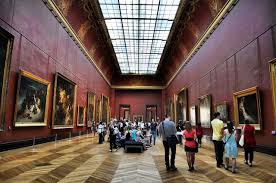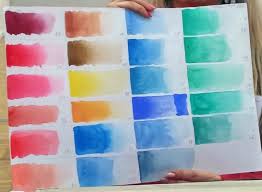HISTORY OF THE ORIGIN AND DEVELOPMENT OF STAINED-GLASS ART (part 2)
 Let us imagine for a moment the decoration of these choirs: painted walls and ceilings, glazed tiled stoves, patterned carpets and carved shutters … In the interiors of rich chambers, only windows could remain colorless spots. Stained-glass windows — multicolored glasses and mica plates assembled in the pattern — helped to solve the problem, complementing the atmosphere of the luxurious life of the then aristocracy. “The colored light that now penetrated through the glass and mica stained-glass windows created a special, joyful mood, made the interior cozy, complemented the beauty of the brightly-patterned decoration of the room.”
Let us imagine for a moment the decoration of these choirs: painted walls and ceilings, glazed tiled stoves, patterned carpets and carved shutters … In the interiors of rich chambers, only windows could remain colorless spots. Stained-glass windows — multicolored glasses and mica plates assembled in the pattern — helped to solve the problem, complementing the atmosphere of the luxurious life of the then aristocracy. “The colored light that now penetrated through the glass and mica stained-glass windows created a special, joyful mood, made the interior cozy, complemented the beauty of the brightly-patterned decoration of the room.”
Appeared in the 30s. In the 19th century, bilateral watercolors on glass, the image of which appeared only under directed artificial lighting, were shown to the sounds of music in a mysterious atmosphere, as if uniting various types of arts, feelings and emotions.
Scientists report that the first Russian stained-glass windows, in contrast to imported counterparts, were a “primitive mosaic of colored glass, painted in bulk, inserted into the window cover without additional surface decoration. Experiments, they say, include painting the glass in a cold way – with oil paints and imitating stained glass using an image on paper attached to window glass. ”
In an era of revitalization of Russian contacts with Western Europe, stained-glass windows in the construction and decoration of palaces are most prevalent. This was facilitated by the enthusiasm of the nobility for pseudo-Gothic, when stained-glass windows became a certain obligatory attribute. Colored windows decorated then many luxurious buildings, in particular, the cottage and the church of St. Alexander Nevsky in Peterhof Alexandria, the chapel tower in Tsarskoye Selo, Pavilion Farm in Pavlovsk, etc.
In the era of Art Nouveau landscape, plot, ornamental types of stained-glass windows are widespread. Famous “stained glass charade” of the architect F. Schechtel in the Ryabushinsky mansion on Malaya Nikitskaya in Moscow; landscape panels with a motive of the northern, Scandinavian winter, decorating the staircase of the first floor of the apartment building of the Rossiya insurance company on Bolshaya Morskaya in St. Petersburg; stained-glass windows of the Metropol Hotel and the Nationals in Moscow, etc. The Gothic era attracted the famous M. Vrubel, who created the “Knight” stained glass window for Morozova’s house, where, according to art historians, one can feel the influence of the traditions of the Italian Renaissance.
During the heyday of eclecticism, stained-glass windows are traditionally widespread in Russia, especially in everyday life. So it was already in the middle of the XIX century. As if in contrast to the “open” environment enfilades of classicism, a colored window closed the interior, fenced the inhabitants of the house from the outside world. Flowers on window sills, special screens made of fabric, paper, art glass pursued a common goal: “they did not allow the environment to invade the inner world of man.” In boudoirs, smoking rooms, bathrooms, decorated, as a rule, in one of the oriental styles, stained glass has become an almost mandatory accessory.
By the beginning of the 20th century stained-glass windows could be seen not only in cathedral, monastery, parish, house churches and other churches, but also in state, educational institutions and even in the buildings of a number of industrial enterprises.
As noted above, modern technology, taking into account the artistic experience of previous eras, brought the skill of creating art stained-glass windows to a new level.
A significant step forward was the development by one American company of a seamless method of manufacturing stained glass on any sheet glass by using double-sided lead broaching, as well as special stained glass coatings based on organic dyes.
The use of flat glass today allows the use of stained glass in double-glazed windows in compliance with all technological standards, and stained-glass windows made on a softer and safer acrylic glass can be inserted into a suspended ceiling.
In the modern world, methods of art making glass without metal broaches marking the borders of colors are becoming increasingly popular. One of them is casting, or casting of material similar to the famous Murano glass in Russia. Another is fusing, or sintering of glass. Unlike typical tiles made using the casting technique, stained glass windows made using the sintering technique can have any shape, various thickness and texture. Fragments of such glass are increasingly used in modern interiors. In particular, to create partitions, art inserts in the walls, double-glazed windows, etc. They can also be created in the form of glass panels, paintings, watch cases, lamps, countertops, furniture, etc.


